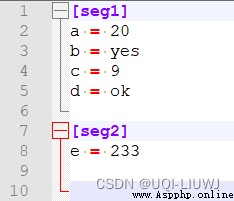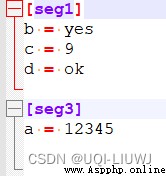適用於配置ini文件的格式,可以包含一個或多個節(section),每個節可以有多個參數(鍵=值)。
import configparser
#庫導入
config = configparser.ConfigParser()
#實例化一個config對象
config["seg1"] = {'a': '20',
'b': 'yes',
'c': '9',
'd':'ok'}
config['seg2'] = {'e':'233'}
#seg1,seg2是config這一個section的名稱
#類似於操作字典的形式
with open('example.ini', 'w') as configfile:
config.write(configfile)
#將config對象寫入文件於是在路徑上出現了一個example.ini文件。用記事本打開後是如下形式

import configparser
#庫導入
config = configparser.ConfigParser()
#實例化一個對象
print(config.sections())
#[]
#此時config對象沒有segment
config.read('example.ini')
print(config.sections())
#['seg1', 'seg2']
#讀取我們之前寫入的ini文件,有兩個segment
'seg1' in config
#True
'seg3' in config
#False
'''
根據名字判斷一個segment在不在config裡面
'''
config['seg1']
# <Section: seg1>
config['seg1']['a']
# '20'
config.get('seg1','a')
# '20'
'''
讀取config裡面的值
'''
for key in config['seg1']:
print(key)
'''
a
b
c
d
'''
config.options('seg1')
'''
['a', 'b', 'c', 'd']
'''
#某一個segment裡面所有的key
config.items('seg1')
# [('a', '20'), ('b', 'yes'), ('c', '9'), ('d', 'ok')]
# 某一個segment裡面所有的鍵值對
config.add_section('seg3')
#添加segment
config.remove_section('seg2')
#移除segment
config.remove_option('seg1','a')
#移除某一項
config.set('seg3','a','12345')
#設置某一項
with open('example2.ini','w') as f:
config.write(f)得到的結果是
